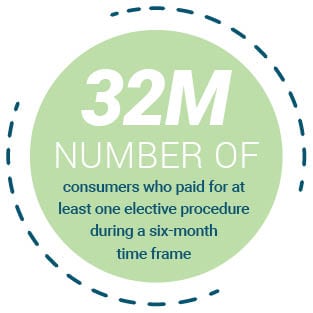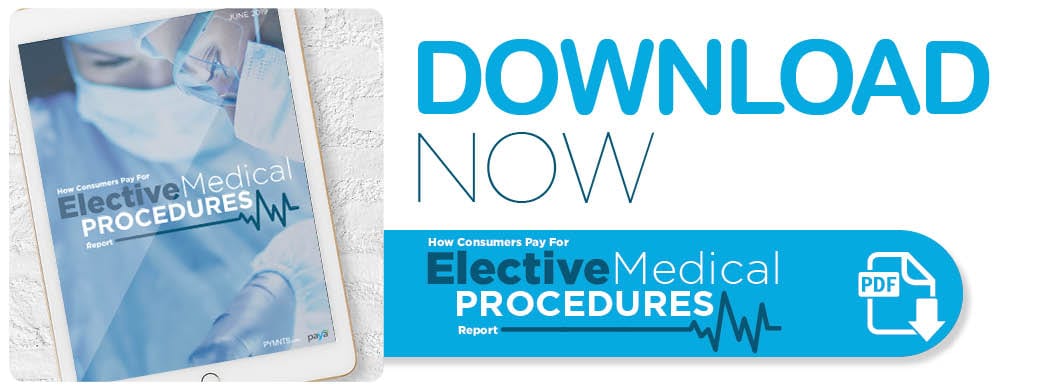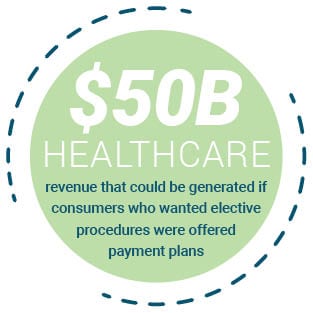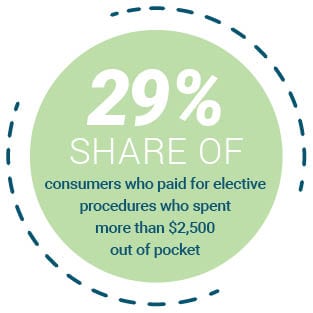Solving The $50B Elective Medical Procedure Payments Problem

The demand for elective medical procedures in the U.S. is sky-high, but high costs severely limit consumers’ access to them.
The elective medical procedures market is 63 million consumers-strong, and accounts for as much as 10 percent of America’s healthcare economy. That adds up to a collective $171 billion in elective medical procedures each year.
In addition to the 63 million consumers who pay for at least one elective procedure each year, another 50 million wanted — but chose to forego — a procedure, or chose to not fund a procedure on behalf of a loved one. What is keeping so many consumers from paying for the elective medical procedures they want?
 In the How Consumers Pay For Elective Medical Procedures Report, in collaboration with Paya, PYMNTS examined survey response data from 998 American consumers interested in obtaining elective medical care for themselves or their loved ones to find out. The census-balanced survey asked consumers a wide array of questions regarding the types of procedures for which they were interested in paying, their reasons for choosing to commit to them and how the availability of payment plans may have impacted their decisions.
In the How Consumers Pay For Elective Medical Procedures Report, in collaboration with Paya, PYMNTS examined survey response data from 998 American consumers interested in obtaining elective medical care for themselves or their loved ones to find out. The census-balanced survey asked consumers a wide array of questions regarding the types of procedures for which they were interested in paying, their reasons for choosing to commit to them and how the availability of payment plans may have impacted their decisions.
The research found a number of reasons why consumers might opt out of paying for elective medical procedures, but the most common was that they simply could not afford them. Out of the 50 million American consumers who wanted to pay for elective procedures for either themselves or loved ones, 44 percent opted out because could not pay for the procedures they wanted.
This is understandable: Elective procedures are expensive, and many insurance policies do not cover their high costs. In the six-month time frame prior to the survey, as much as 54.4 percent of consumers who paid for elective procedures paid anywhere from $500 to more than $2,500 out of pocket.
Luckily, paying all at once is not the only option. In fact, 20 percent of consumers who explored the possibility of paying for elective procedures said their doctors offered them payment plans. Another 11.2 percent said third-party providers offered them payment plans, and 7.3 percent said they were offered payment plans by both their healthcare providers and third-party payment service providers.
Yet, this leaves 61.5 percent of consumers who were never offered the chance to pay for procedures in installments. This is not only to their own detriment, but to the detriment of healthcare providers, which are essentially foregoing billions in potential revenue by not offering payment plan options.
The report details what healthcare providers need to know about how payment plans can help them reach new customers and expand their bottom lines.
Key findings in the report include:
- 9 percent: Share of consumers who considered elective care, but opted out because they could not afford it
- $18.4 billion: Potential revenue for healthcare providers to gain by offering payment plans for cosmetic surgery
- 9 percent: Share of consumers who paid for at least one elective procedure in the past six months, whose cost significantly applied to their deductible
To learn more about how payment plans can benefit American elective medical care providers, download the report.
About the Report
The How Consumers Pay For Elective Medical Procedures Report, a PYMNTS and Paya collaboration, analyzed the survey responses of 998 American consumers who considered paying for elective medical procedures during a six-month period. The data was used to examine the factors preventing them from purchasing the procedures they wanted, and how payment plans can help medical practitioners extend services to more patients and boost their bottom lines.



